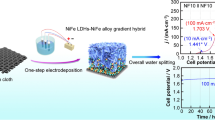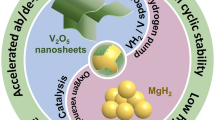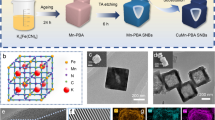Abstract
Surface Ag granular packs (SAgPs) have been fabricated from dual-phase Ag35.5Zn64.5 precursor alloy consisting of both ε and γ phases by using a facile one-step triangle wave potential cycling in 0.5 mol·L−1 KOH. During the continuous potential cyclic sweeping, the γ phases preferentially dissolve during the anodic scan and dominant reduction reactions of Ag cations lead to redeposition and accumulation of Ag atoms together to form SAgPs during cathodic scan. The ε phases stay inactive to form a continuous skeleton in the inner regions. SAgPs with an average particle size of 94–129 nm can be obtained at scan rates of 25, 50 and 100 mV·s−1 for 100 triangle wave potential cycles. SAgPs formed at a scan rate of 50 mV·s−1 exhibit superior oxygen reduction reaction performances with the onset potential of 0.93 V, half-wave potential of 0.72 V and an electron transfer number of 4.0. The above-mentioned SAgPs have superior stabilities as ORR catalysts.
Graphic abstract












Similar content being viewed by others
References
Li Z, Fu JY, Feng Y, Dong CK, Liu H, Du XW. A silver catalyst activated by stacking faults for the hydrogen evolution reaction. Nature Catal. 2019;2:1107.
Shimizu K, Miyamoto Y, Satsuma A. Size- and support-dependent silver cluster catalysis for chemoselective hydrogenation of nitroaromatics. J Catal. 2010;270(1):86.
Yi QF, Li L, Yu WQ, Liu XP, Zhou ZH, Nie HD. Novel nanoporous binary Ag-Ni electrocatalysts for hydrazine oxidation. Rare Met. 2010;29(1):26.
Wang JC, Luo HS, Zhang MH, Zu XH, Zhang J, Gu YX, Yi GB. Design and fabrication of a new fluorescence enhancement system of silver nanoparticles-decorated aligned silver nanowires. Rare Met. 2019;38(12):1178.
Ajitha B, Ashok Kumar Reddy Y, Sreedhara Reddy P, Jeon HJ, Ahn CW. Role of capping agents in controlling silver nanoparticles size, antibacterial activity and potential application as optical hydrogen peroxide sensor. R Soc Chem. 2016;6(42):36171.
Zhang C, Qian LH, Zhang K, Yuan SL, Xiao JW, Wang S. Hierarchical porous Ni/NiO core-shell with superior conductivity for electrochemical pseudo-capacitor and glucose sensor. J Mater Chem A. 2015;3(19):10519.
Wei LY, Lu JR, Xu HZ, Patel A, Chen ZS, Chen GF. Silver nanoparticles: synthesis, properties, and therapeutic applications. Drug Discov Today. 2015;20(5):595.
Lee CL, Chio HP, Syu CM, Wu CC. Silver triangular nanoplates as electrocatalyst for oxygen reduction reaction. Electrochem Commun. 2010;12(11):1609.
Pradhan N, Pal A, Pal T. Silver nanoparticle catalyzed reduction of aromatic nitro compounds. Colloid Surf A Physicochem Eng Asp. 2002;196(2):247.
NgocBui MP, Pham XH, Han KN, Li CA, Kim YS, Seong GH. Electrocatalytic reduction of hydrogen peroxide by silver particles patterned on single-walled carbon nanotubes. Sensor Actuat B-Chem. 2010;150(1):436.
Kästner C, Thünemann AF. Catalytic reduction of 4-nitrophenol using silver nanoparticles with adjustable activity. Langmuir. 2016;32(29):7383.
Hebeish A, Hashem M, El-Hady A, Hady MM, Sharaf S. Development of CMC hydrogels loaded with silver nano-particles for medical applications. Carbohydr Polym. 2013;92(1):407.
Patra S, Naik AN, Pandey AK, Sen D, Mazumder S, Goswami A. Silver nanoparticles stabilized in porous polymer support: a highly active catalytic nanoreactor. Appl Catal A Gen. 2016;524:214.
Zhou KR, He JR, Wang XQ, Lin J, Jing Y, Zhang WL, Chen YF. Self-assembled CoSe2 nanocrystals embedded into carbon nanowires as highly efficient catalyst for hydrogen evolution reaction. Electrochim Acta. 2017;231:626.
He JR, Chen YF, Manthiram A. Metal sulfide-decorated carbon sponge as a highly efficient electrocatalyst and absorbant for polysulfide in high-Loading Li2S batteries. Adv Energy Mater. 2019;9(20):1900584.
Corro G, Pal U, Ayala E, Vidal E. Diesel soot oxidation over silver-loaded SiO2 catalysts. Catal Today. 2013;212:63.
Boskovic I, Mentus SV, Pjescic M. Electrochemical behavior of an Ag/TiO2 composite surfaces. Electrochim Acta. 2006;51(14):2793.
Chatenet M, Genies-Bultel L, Aurousseau M, Durand R, Andolfatto F. Oxygen reduction on silver catalysts in solutions containing various concentrations of sodium hydroxide: comparison with platinum. J Appl Electrochem. 2002;32(10):1131.
Linge JM, Erikson H, Kozlova J, Aruväli J, Sammelselg V, Tammeveski K. Oxygen reduction on electrodeposited silver catalysts in alkaline solution. J Solid State Electrochem. 2018;22(1):81.
Linge JM, Eriksona H, Kozlova J, Sammelselg V, Tammeveski K. Oxygen reduction reaction on electrochemically deposited silver nanoparticles from non-aqueous solution. J Electroanal Chem. 2018;810:129.
Treshchalov A, Erikson H, Puust L, Tsarenko S, Saar R, Vanetsev A, Tammeveski K, Sildos I. Stabilizer-free silver nanoparticles as efficient catalysts for electrochemical reduction of oxygen. J Colloid Interface Sci. 2017;491:358.
Ohyama J, Okata Y, Watabe N, Katagiri M, Nakamura A, Arikawa H, Shimizu K, Takeguchi T, Ueda W, Satsuma A. Oxygen reduction reaction over silver particles with various morphologies and surface chemical states. J Power Sources. 2014;245:998.
Garlyyev B, Liang YC, Butt FK, Bandarenka AS. Engineering of highly active silver nanoparticles for oxygen electroreduction via simultaneous control over their shape and size. Adv Sustain Syst. 2017;1(12):1700117.
Singh P, Buttry DA. Comparison of oxygen reduction reaction at silver nanoparticles and polycrystalline silver electrodes in alkaline solution. J Phys Chem C. 2012;116(19):10656.
Gupta RK, Verma AD, Sinha I, Malviya M. Oxygen reduction reaction on anisotropic silver nanoparticles in alkaline media. Chem Phys Lett. 2017;680:6.
Cleve TV, Gibara E, Linic S. Electrochemical oxygen reduction reaction on Ag nanoparticles of different shapes. ChemCatChem. 2016;8(1):256.
Han JJ, Li N, Zhang TY. Ag/C nanoparticles as an cathode catalyst for a zinc-air battery with a flowing alkaline electrolyte. J Power Sources. 2009;193(2):885.
Innocenti M, Zafferoni C, Lavacchi A, Becucci L, Di Benedetto F, Carretti E, Vizza F, Foresti ML. Electroactivation of microparticles of silver on glassy carbon for oxygen reduction and oxidation reactions. J Electrochem Soc. 2014;161(7):D3018.
Salome S, Rego R, Oliveira MC. Development of silver-gasdiffusion electrodes for the oxygen reduction reaction by electrodeposition. Mater Chem Phys. 2013;143(1):109.
Wang QY, Cui XQ, Guan WM, Zhang L, Fan XF, Shi Z, Zheng WT. Shape-dependent catalytic activity of oxygen reduction reaction (ORR) on silver nanodecahedra and nanocubes. J Power Sources. 2014;269:152.
Lee CL, Tsai YL, Huang CH, Huang KL. Performance of silver nanocubes based on electrochemical surface area for catalyzing oxygen reduction reaction. Electrochem Commun. 2013;29:37.
Erikson H, Sarapuu A, Tammeveski K. Oxygen reduction reaction on silver catalysts in alkaline media: a minireview. ChemElectroChem. 2019;6(1):73.
Wang ZL, Ning SC, Liu P, Ding Y, Hirata A, Fujita T, Chen MW. Tuning surface structure of 3D nanoporous gold by surfactant-free electrochemical potential cycling. Adv Mater. 2017;29(41):1703601.
Yang YL, Dan ZH, Liang YF, Wang Y, Qin FX, Chang H, Hara N. Morphological manipulation of tin nanostructures via pulse width modulation of potential step cycling in hydrochloric acid containing polyvinylpyrrolidone. J Electrochem Soc. 2019;166(8):D258.
Gómez-Acebo T. Thermodynamic assessment of the Ag-Zn system. Calphad. 1998;22(2):203.
Ming C, Park SM. Spectroelectrochemical studies on dissolution and passivation of zinc electrodes in alkaline solutions. J Electrochem Soc. 1996;143(7):2125.
Park HJ, Mho SI. Electrochemical impedance spectroscopy and voltammetry of zinc in dilute alkaline solutions. Anal Sci. 1997;13:311.
Tilak BV, Perkins RS, Kozlowska HA, Conway BE. Impedance and formation characteristics of electrolytically generated silver oxides: I formation and reduction of surface oxides and the role of dissolution processes. Electrochim Acta. 1972;17(8):1447.
Droog JMM, Alderliesten PT, Bootsma GA. Initial stages of anodic oxidation of silver in sodium hydroxide solution studied by potential sweep voltammetry and ellipsometry. J Electroanal Chem Interfac Electrochem. 1979;99(2):173.
Perkins RS, Tilak BV, Conway BE. Impedance and formation characteristics of electrolytically generated silver oxides: II Photo-effects. Electrochim Acta. 1972;17(8):1471.
Burstein GT, Newman RC. Anodic behaviour of scratched silver electrodes in alkaline solution. Electrochim Acta. 1980;25(8):1009.
AbdEI Rehim SS, Hassan HH, Ibrahim MAM, Amin MA. Electrochemical behaviour of a silver electrode in NaOH solutions. Monatshefte fuer Chem. 1998;129(11):1103.
Iwasaki N, Sasaki Y, Nishina Y. Ag electrode reaction in NaOH solution studied by in-situ Raman spectroscopy. Surf Sci. 1988;198(3):524.
Mao LQ, Zhang D, Sotomura T, Nakatsu K, Koshiba N, Ohsaka T. Mechanistic study of the reduction of oxygen in air electrode with manganese oxides as electro-catalysts. Electrochim Acta. 2003;48(8):1015.
Tammeveski L, Erikson H, Sarapuu A, Kozlova J, Ritslaid P, Sammelselg V, Tammeveski K. Electrocatalytic oxygen reduction on silver nanoparticle/multi- walled carbon nanotube modified glassy carbon electrodes in alkaline solution. Electrochem Commun. 2012;20:15.
Tiwari A, Nagaiah TC. Dioxygen reduction by nitrogen-rich mesoporous carbon bearing electrodeposited silver particles. ChemCatChem. 2016;8(2):396.
Boukhvalov DW, Son YW. Oxygen reduction reactions on pure and nitrogen-doped graphene: a first-principles modeling. Nanoscale. 2012;4(2):417.
Wang ZG, Li Q, Xu HX, Dahl-Petersen C, Yang Q, Cheng DJ, Cao DP, Besenbachera F, Lauritsena JV, Helvegd S, Dong MD. Controllable etching of MoS2 basal planes for enhanced hydrogen evolution through the formation of active edge sites. Nano Energy. 2018;49:634.
Acknowledgements
This work was financially supported by the State Key Laboratory of Advanced Metals and Materials (No. 2018-ZD04), the State Key Laboratory of Metal Material for Marine Equipment and Application (No. SKLMEA-K201806), the Natural Science Foundation of China (Nos. 51671106 and 51931008), the Natural Science Foundation of Jiangsu Province (Nos. BK20171424 and BE2019119) and the National Defense Basic Scientific Research Program of China (No. JCKY08414C020).
Author information
Authors and Affiliations
Corresponding author
Rights and permissions
About this article
Cite this article
Luo, JY., Han, PP., Dan, ZH. et al. Electrocatalytic oxygen reduction performances of surface Ag granular packs electrodeposited from dual-phase Ag35.5Zn64.5 precursor alloys by triangle wave potential cycling. Rare Met. 40, 3531–3542 (2021). https://doi.org/10.1007/s12598-020-01700-1
Received:
Revised:
Accepted:
Published:
Issue Date:
DOI: https://doi.org/10.1007/s12598-020-01700-1




